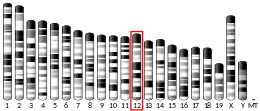DIO2
Type II iodothyronine deiodinase (iodothyronine 5'-deiodinase, iodothyronine 5'-monodeiodinase) is an enzyme that in humans is encoded by the DIO2 gene.[5][6][7]
Function
The protein encoded by this gene belongs to the iodothyronine deiodinase family. It activates thyroid hormone by converting the prohormone thyroxine (T4) by outer ring deiodination (ORD) to bioactive 3,3',5-triiodothyronine (T3). It is highly expressed in the thyroid, and may contribute significantly to the relative increase in thyroidal T3 production in patients with Graves' disease and thyroid adenomas. This protein contains selenocysteine (Sec) residues encoded by the UGA codon, which normally signals translation termination. The 3' UTR of Sec-containing genes have a common stem-loop structure, the Sec insertion sequence (SECIS), which is necessary for the recognition of UGA as a Sec codon rather than as a stop signal. Alternative splicing results in multiple transcript variants encoding different isoforms.[7]
See also
References
- GRCh38: Ensembl release 89: ENSG00000211448 - Ensembl, May 2017
- GRCm38: Ensembl release 89: ENSMUSG00000007682 - Ensembl, May 2017
- "Human PubMed Reference:". National Center for Biotechnology Information, U.S. National Library of Medicine.
- "Mouse PubMed Reference:". National Center for Biotechnology Information, U.S. National Library of Medicine.
- Croteau W, Davey JC, Galton VA, St Germain DL (Sep 1996). "Cloning of the mammalian type II iodothyronine deiodinase. A selenoprotein differentially expressed and regulated in human and rat brain and other tissues". J Clin Invest. 98 (2): 405–417. doi:10.1172/JCI118806. PMC 507444. PMID 8755651.
- Araki O, Murakami M, Morimura T, Kamiya Y, Hosoi Y, Kato Y, Mori M (Jun 1999). "Assignment of type II iodothyronine deiodinase gene (DIO2) to human chromosome band 14q24.2→q24.3 by in situ hybridization". Cytogenet Cell Genet. 84 (1–2): 73–74. doi:10.1159/000015218. PMID 10343107.
- "Entrez Gene: DIO2 deiodinase, iodothyronine, type II".
- Curcio-Morelli C, Zavacki AM, Christofollete M, Gereben B, de Freitas BC, Harney JW, Li Z, Wu G, Bianco AC (July 2003). "Deubiquitination of type 2 iodothyronine deiodinase by von Hippel-Lindau protein-interacting deubiquitinating enzymes regulates thyroid hormone activation". J. Clin. Invest. 112 (2): 189–96. doi:10.1172/JCI18348. PMC 164294. PMID 12865408.
Further reading
- Gereben B, Salvatore D (2006). "Pretranslational regulation of type 2 deiodinase". Thyroid. 15 (8): 855–864. doi:10.1089/thy.2005.15.855. PMID 16131328.
- Andersson B, Wentland MA, Ricafrente JY, et al. (1996). "A "double adaptor" method for improved shotgun library construction". Anal. Biochem. 236 (1): 107–113. doi:10.1006/abio.1996.0138. PMID 8619474.
- Salvatore D, Tu H, Harney JW, Larsen PR (1996). "Type 2 iodothyronine deiodinase is highly expressed in human thyroid". J. Clin. Invest. 98 (4): 962–968. doi:10.1172/JCI118880. PMC 507511. PMID 8770868.
- Yu W, Andersson B, Worley KC, et al. (1997). "Large-scale concatenation cDNA sequencing". Genome Res. 7 (4): 353–8. doi:10.1101/gr.7.4.353. PMC 139146. PMID 9110174.
- Buettner C, Harney JW, Larsen PR (1999). "The 3'-untranslated region of human type 2 iodothyronine deiodinase mRNA contains a functional selenocysteine insertion sequence element". J. Biol. Chem. 273 (50): 33374–33378. doi:10.1074/jbc.273.50.33374. PMID 9837913.
- Bartha T, Kim SW, Salvatore D, et al. (2000). "Characterization of the 5'-flanking and 5'-untranslated regions of the cyclic adenosine 3',5'-monophosphate-responsive human type 2 iodothyronine deiodinase gene". Endocrinology. 141 (1): 229–237. doi:10.1210/en.141.1.229. PMID 10614643.
- Baqui MM, Gereben B, Harney JW, et al. (2000). "Distinct subcellular localization of transiently expressed types 1 and 2 iodothyronine deiodinases as determined by immunofluorescence confocal microscopy". Endocrinology. 141 (11): 4309–4312. doi:10.1210/en.141.11.4309. PMID 11089566.
- Ohba K, Yoshioka T, Muraki T (2001). "Identification of two novel splicing variants of human type II iodothyronine deiodinase mRNA". Mol. Cell. Endocrinol. 172 (1–2): 169–175. doi:10.1016/S0303-7207(00)00368-3. PMID 11165050.
- Imai Y, Toyoda N, Maeda A, et al. (2002). "Type 2 iodothyronine deiodinase expression is upregulated by the protein kinase A-dependent pathway and is downregulated by the protein kinase C-dependent pathway in cultured human thyroid cells". Thyroid. 11 (10): 899–907. doi:10.1089/105072501753210957. PMID 11716036.
- Molnár I, Balázs C, Szegedi G, Sipka S (2002). "Inhibition of type 2,5'-deiodinase by tumor necrosis factor alpha, interleukin-6 and interferon gamma in human thyroid tissue". Immunol. Lett. 80 (1): 3–7. doi:10.1016/S0165-2478(01)00301-7. PMID 11716958.
- Kuiper GG, Klootwijk W, Visser TJ (2002). "Substitution of cysteine for a conserved alanine residue in the catalytic center of type II iodothyronine deiodinase alters interaction with reducing cofactor". Endocrinology. 143 (4): 1190–1198. doi:10.1210/en.143.4.1190. PMID 11897672.
- Gereben B, Kollár A, Harney JW, Larsen PR (2003). "The mRNA structure has potent regulatory effects on type 2 iodothyronine deiodinase expression". Mol. Endocrinol. 16 (7): 1667–1679. doi:10.1210/me.16.7.1667. PMID 12089359.
- Baur A, Buchfelder M, Köhrle J (2002). "Expression of 5'-deiodinase enzymes in normal pituitaries and in various human pituitary adenomas". Eur. J. Endocrinol. 147 (2): 263–268. doi:10.1530/eje.0.1470263. PMID 12153750.
- Botero D, Gereben B, Goncalves C, et al. (2003). "Ubc6p and ubc7p are required for normal and substrate-induced endoplasmic reticulum-associated degradation of the human selenoprotein type 2 iodothyronine monodeiodinase". Mol. Endocrinol. 16 (9): 1999–2007. doi:10.1210/me.2002-0135. PMID 12198238.
- Strausberg RL, Feingold EA, Grouse LH, et al. (2003). "Generation and initial analysis of more than 15,000 full-length human and mouse cDNA sequences". Proc. Natl. Acad. Sci. U.S.A. 99 (26): 16899–16903. doi:10.1073/pnas.242603899. PMC 139241. PMID 12477932.
- Curcio-Morelli C, Gereben B, Zavacki AM, et al. (2003). "In vivo dimerization of types 1, 2, and 3 iodothyronine selenodeiodinases". Endocrinology. 144 (3): 937–946. doi:10.1210/en.2002-220960. PMID 12586771.
- Ambroziak M, Pachucki J, Chojnowski K, et al. (2003). "Pax-8 expression correlates with type II 5' deiodinase expression in thyroids from patients with Graves' disease". Thyroid. 13 (2): 141–148. doi:10.1089/105072503321319440. PMID 12699588.
- Dentice M, Morisco C, Vitale M, et al. (2004). "The different cardiac expression of the type 2 iodothyronine deiodinase gene between human and rat is related to the differential response of the Dio2 genes to Nkx-2.5 and GATA-4 transcription factors". Mol. Endocrinol. 17 (8): 1508–1521. doi:10.1210/me.2002-0348. PMID 12775767.



